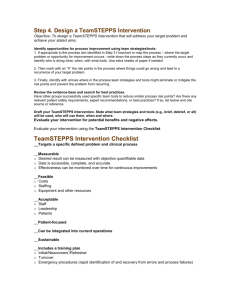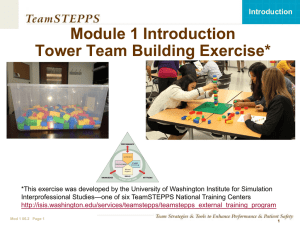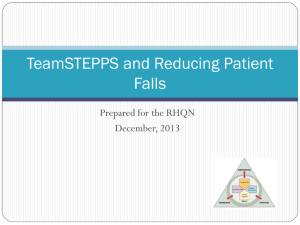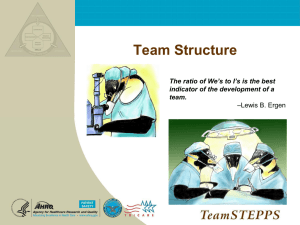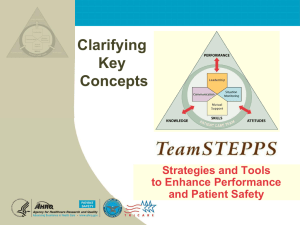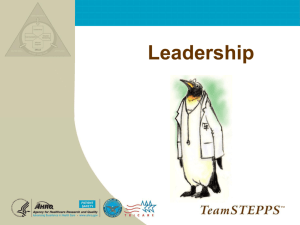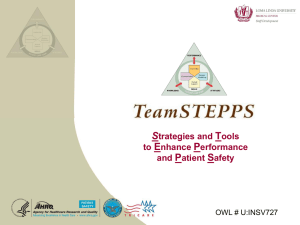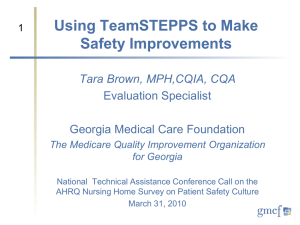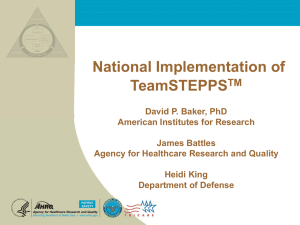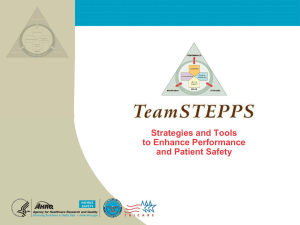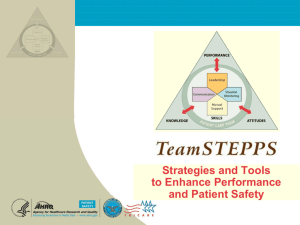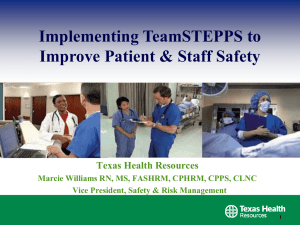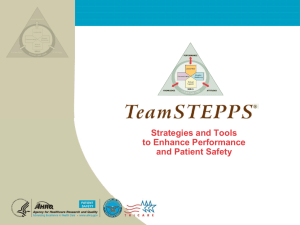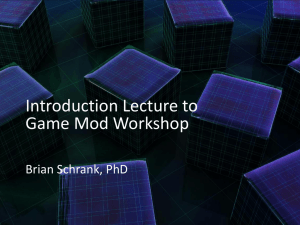Program Evaluation of Medical Team Training in the DoD
advertisement
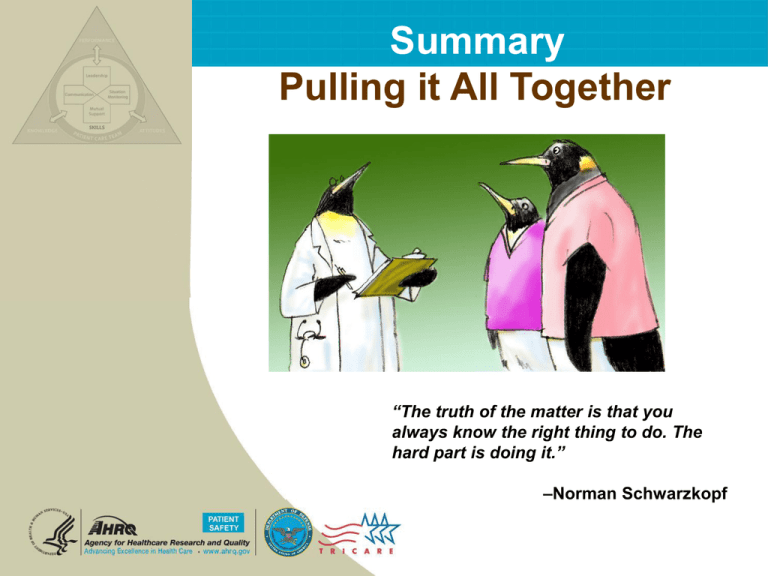
Summary Pulling it All Together “The truth of the matter is that you always know the right thing to do. The hard part is doing it.” –Norman Schwarzkopf Summary— Pulling it All Together Day 1 Objectives 1. Explain the theoretical framework and evidence base that supports the use of team skills to improve safety culture. 2. Learn the team skills that enhance performance and patient safety. Mod 7 06.1 Page 2 TEAMSTEPPS 05.2 2 Summary— Pulling it All Together The Theory Mutual Performance Monitoring Team Leadership Team Orientation Back-up Behavior Shared Mental Models Mutual Trust Adaptability Big 5 Coord. Mechanism Mod 7 06.1 Page 3 Team Effectiveness Closed Loop Communication TEAMSTEPPS 05.2 Salas, Sims, Burke. Is there a “Big Five” in teamwork? Small Group Research. 2005; 36:555-599. 3 Summary— Pulling it All Together The Framework: What Comprises Team Effectiveness? Knowledge Cognitions “Think” Attitudes Affect “Feel” Skills Behaviors “Do” Mod 7 06.1 Page 4 TEAMSTEPPS 05.2 …team performance is a science…consequences of errors are great… 4 More Evidence Summary— Pulling it All Together Exploding Literature − Patient Care Team + Evidence-Based Practice = 1,128 − Patient Care Team + Evaluation Studies = 843 Studies in diverse patient populations demonstrate relationship between teamwork and − Improved clinical processes − Reduction in medical errors − Improved surgical team performance − Increased adherence to guidelines − Decreased length of stay − Increased functional status − Decreased mortality Salas et al. What are the critical success factors for team training in health care? Jt Comm Jrnl Qual Safe. 2009;35:398-405. Mod 7 06.1 Page 5 TEAMSTEPPS 05.2 Summary— Pulling it All Together The Bottom Line…. The knowledge, skills, attitudes, language, and coordinating mechanisms inherent in teamwork1 create the flexibility team members need to manage complexity2 and learn from experience.3-5 1. Salas E, Sims DE, Burke CS. Is there a "Big Five" in teamwork? Small Group Research. 2005;36:555-599. 2. Cannon-Bowers JA, Salas E. Team performance and training in complex environments: Recent findings from applied research. Curr Dir Psychol Sci. 1998;7:83-87. 3. Senge PM. The Fifth Discipline: The Art & Practice of the Learning Organization. New York, NY: Doubleday; 1990. 4. Edmonson AC. Learning from failure in health care: Frequent opportunities, pervasive barriers. Qual Saf Health Care. 2004;12(Suppl II):ii3-ii9. 5. Salas E, Rosen MA, Burke CS, Goodwin GF. The wisdom of collectives in organizations: An update of the teamwork competencies. In: Salas E, Goodwin GF, Burke CS, eds. Team effectiveness in complex organizations: Cross-disciplinary perspectives and approaches. New York, NY: Routledge/Taylor & Francis Group; 2009:39-79. Mod 7 06.1 Page 6 TEAMSTEPPS 05.2 6 Summary— Pulling it All Together Barriers, Tools/Strategies, Outcomes BARRIERS Inconsistency in Team Membership Lack of Time Lack of Information Sharing Hierarchy Defensiveness Conventional Thinking Complacency Varying Communication Styles Conflict Lack of Coordination and Follow-Up with Co-Workers Distractions Fatigue Workload Misinterpretation of Cues Lack of Role Clarity Mod 7 06.1 Page 7 TOOLS and STRATEGIES Brief Huddle Debrief STEP I’M SAFE Checklist Cross Monitoring Feedback Advocacy and Assertion Two-Challenge Rule CUS DESC Script Collaboration SBAR Call-Out Check-Back Handoff TEAMSTEPPS 05.2 OUTCOMES Shared Mental Model Adaptability Team Orientation Mutual Trust Team Performance Patient Safety!! Team Goals 7 The Constraints Competing Values & Expectations Summary— Pulling it All Together Complexity of patients and systems Desired Outcomes Limited resources Mod 7 06.1 Page 8 Behavioral Choices of Fallible Human Beings TEAMSTEPPS 05.2 Summary— Pulling it All Together Identifying Opportunities to Use TeamSTEPPS Tools and Strategies Insert video Vig aLg001 Mod 7 06.1 Page 9 TEAMSTEPPS 05.2 9 Summary— Pulling it All Together Discussion What were the barriers to communication? Lack of information sharing, lack of follow-up, lack of role clarity, misinterpretation of cues, workload Which TeamSTEPPS tools and strategies could have been used? (Consult your Pocket Guide) STEP, huddle, SBAR What is the biggest issue in terms of teamwork skills? Mod 7 06.1 Page 10 TEAMSTEPPS 05.2 10 Using TeamSTEPPS Tools and Strategies Summary— Pulling it All Together Insert video Vig 2bLg001 Mod 7 06.1 Page 11 TEAMSTEPPS 05.2 11 Summary— Pulling it All Together Case Analysis Divide yourselves into groups of 4 - 5 Discuss the scenario in your team Identify the barriers to teamwork that occurred Identify tools, strategies to address the barriers Report out to the whole group Mod 7 06.1 Page 12 TEAMSTEPPS 05.2 12 Summary Summary— Pulling it All Together During this training, we learned that teamwork strategies and tools— Create a safety net for fallible human beings (human factors) Do not come naturally…must be learned (evidencebased training) Create the flexibility we need to manage complexity and learn from experience What we didn’t learn… for Master Trainers One shot didactic lectures can not change people’s behavior Human beings and organizations adopt new behaviors in stages as a result of a change strategy Mod 7 06.1 Page 13 TEAMSTEPPS 05.2 13 Summary— Pulling it All Together “To improve teamwork in support of patient safety, what small change can you commit to?” “The achievements of an organization are the results of the combined effort of each individual.” –Vince Lombardi Mod 7 06.1 Page 14 TEAMSTEPPS 05.2 14
